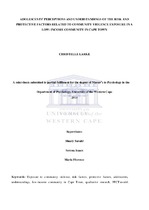| dc.description.abstract | There is widespread evidence that exposure to community violence is escalating at an alarming rate, not only in South Africa, but worldwide. The literature indicates that the cohort affected is primarily children and adolescents. Whilst a significant amount of empirical research focuses on exposure to community violence and the identification of risk and protective factors, there is a paucity of initiatives providing in-depth investigations into the dynamics of these factors. An explorative study grounded in the meanings which adolescents assign to risk and protective factors is essential to provide comprehensive and sensitive care to adolescents exposed to community violence. The aim of this study was to explore adolescents’ perceptions and understandings of the risk and protective factors related to community violence exposure in a low-income community in Cape Town. The current study utilised the PPCT model as it allowed the researcher to explore the way in which risk and protective factors function within different systems. Data was collected from 50 adolescents between the ages of 12 and 15. Five focus groups were used to collect the data, consisting of ten participants each, both males and females. Participants were purposively selected from a high school located in a low-income community in Cape Town. The ethical guidelines stipulated by the UWC and the WCED were strictly followed. Prior to the focus group interviews, informed consent and assent were obtained from both parents and participants. Participants were informed of their rights in the research process. The information collected from participants was analysed by means of a theoretical thematic analysis. This type of thematic analysis aims to identify information gathered, examined and described in rich detail, according to themes from the text, as proposed by Braun and Clarke (2006). This study aimed to contribute to the development of effective interventions and to add to the knowledge base of studies focusing on risk and protective factors associated with exposure to community violence among adolescents | en_US |

